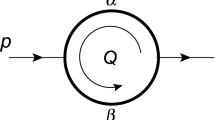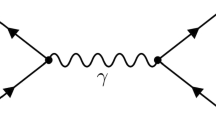Abstract
We provide an overview of the tools and techniques of resurgence theory used in the Borel-Écalle resummation method, which we then apply to the massless Wess–Zumino model. Starting from already known results on the anomalous dimension of the Wess–Zumino model, we solve its renormalisation group equation for the two-point function in a space of formal series. We show that this solution is 1-Gevrey and that its Borel transform is resurgent. The Schwinger–Dyson equation of the model is then used to prove an asymptotic exponential bound for the Borel transformed two-point function on a star-shaped domain of a suitable ramified complex plane. This proves that the two-point function of the Wess–Zumino model is Borel-Écalle summable.
Similar content being viewed by others
Notes
In order to avoid confusion between the kinematic parameter of the two-point function and the length of the path, we will denote the former by the letter \(\Lambda \).
\(f:U\subset \mathbb {C}\longrightarrow \mathbb {C}\) is real if \(f(\bar{z}) =\overline{f(z)}\) whenever both sides of the equation make sense. We require this condition since we want the resummed function to represent a physical quantity.
This was not published since the perturbation around higher singularities of the Borel transform are subdominant and difficult to approach numerically.
At least the first one, but since a singularities in \(\omega \in \mathbb {C}^*\) generally produces new singularities in \(\omega \mathbb {N}^*\) (as in Example 2.12), we expect that all singularities will depend on L, at least in some non-perturbative regime.
This being of course an abuse of language, it is only possible if Eq. (20) is a bound not an equivalence. We are not more precise in order to not burden the text with too much technical details.
References
Zhang, B., Dang, V.: Renormalization of Feynman amplitudes on manifolds by spectral zeta regularization and blow-ups. (2017). arXiv:1712.03490
Pascalie, R.: A Solvable Tensor Field Theory (2019). arXiv:1903.02907
Broadhurst, D.J., Kreimer, D.: Exact solutions of Dyson–Schwinger equations for iterated one-loop integrals and propagator-coupling duality. Nucl. Phys. B 600, 403–422 (2001). arXiv:hep-th/0012146
Clavier, P.J.: Analytic results for Schwinger–Dyson equations with a mass term. Lett. Math. Phys. (2015). https://doi.org/10.1007/s11005-015-0762-1. arXiv:1409.3351
Bersini, J., Maiezza, A., Carlos Vasquez, J.: Resurgence of the renormalization group equation. Ann. Phys. 415. arXiv:1910.14507
Bellon, M.P., Clavier, P.J.: A Schwinger-Dyson equation in the Borel plane: singularities of the solution. Lett. Math. Phys. (2015). https://doi.org/10.1007/s11005-015-0761-2. arXiv:1411.7190
Bellon, M.P., Clavier, P.J.: Alien calculus and a Schwinger–Dyson equation: two-point function with a nonperturbative mass scale. Lett. Math. Phys. 108(2), 391–412 (2016). https://doi.org/10.1007/s11005-017-1016-1. arXiv:1612.07813 [hep-th]
Écalle, J.: Les fonctions résurgentes, vol. 1. Pub. Math, Orsay (1981)
Écalle, J.: Les fonctions résurgentes, vol. 2. Pub. Math, Orsay (1981)
Écalle, J.: Les fonctions résurgentes, vol. 3. Pub. Math, Orsay (1981)
Écalle, J.: Introduction aux fonctions analysables et preuve constructive de la conjecture de Dulac. Hermann (1992)
Menous, F.: Les bonnes moyennes uniformisantes et leurs applications a la resommation reelle. Ph.D. thesis, 1996. Thèse de doctorat dirigée par Écalle, Jean Sciences et techniques communes Paris 11. http://www.theses.fr/1996PA112392 (1996)
Menous, F.: Les bonnes moyennes uniformisantes et une application à la resommation réelle. Annales de la Faculté des sciences de Toulouse: Mathématiques, 6e série 8(4), 579–628 (1999)
Vieillard-Baron, E.: From resurgent functions to real resummation through combinatorial Hopf algebras. Ph.D. thesis, 2014. Thèse de doctorat dirigée par Rolin, Jean-Philippe Mathématiques Dijon. http://www.theses.fr/2014DIJOS005 (2014)
Aniceto, I., Schiappa, R.: Nonperturbative ambiguities and the reality of resurgent transseries. Commun. Math. Phys. 335, 183–245 (2013). arXiv:1308.1115
Schiappa, R., Aniceto, I., Başar, G.: A primer on resurgent transseries and their asymptotics. Phys. Rep. 809, 02 (2018). https://doi.org/10.1016/j.physrep.2019.02.003
Dorigoni, D.: An introduction to resurgence, trans-series and alien calculus. Ann. Phys. (2014). https://doi.org/10.1016/j.aop.2019.167914
Sauzin, D.: Nonlinear analysis with resurgent functions (2012). arXiv:1212.4477v4
Bellon, M.P., Clavier, P.J.: Analyticity domain of a quantum field theory and accelero-summation. Lett. Math. Phys. (2019). https://doi.org/10.1007/s11005-019-01172-0. arXiv:1806.08254
Sokal, A.D.: An improvement of Watson’s theorem on Borel summability. J. Math. Phys. 21(2), 261–263 (1980). https://doi.org/10.1063/1.524408
Costin, O.: On Borel summation and Stokes phenomena for rank-1 nonlinear systems of ordinary differential equations. Duke Math. J. (1998). https://doi.org/10.1215/S0012-7094-98-09311-5. arXiv:math/0608408
Costin, O.: Exponential asymptotics, trans-series and generalized Borel summation for analytic nonlinear rank one systems of ODE’s. arXiv:math/0608414
Menous, F.: The well-behaved catalan and brownian averages and their applications to real resummation. In: Proceedings of the Symposium on Planar Vector Fields (Lleida, 1996). Publ. Mat., vol. 41, pp. 209–222 1997
Bouillot, O.: Invariants Analytiques des Difféomorphismes et MultiZêtas. Ph.D. thesis, Université Paris-Sud, vol. 11. http://tel.archives-ouvertes.fr/tel-00647909 (2011)
Sauzin, D.: Introduction to 1-summability and resurgence (2014). arXiv:1405.0356v1
Sauzin, D., Kamimoto, S.: Iterated convolutions and endless Riemann surfaces. Annali Scuola Normale Superiore - Classe di Scienze (2016). https://doi.org/10.2422/2036-2145.201708008. arxiv:1610.05453v2
Viellard-Baron, E.: Écalle’s averages, Rota–Baxter algebras and the construction of moulds (2019). arXiv:1904.02417v1
Borinsky, M., Dunne, G.V.: Non-perturbative completion of Hopf-algebraic Dyson-Schwinger equations. Nucl. Phys. B 957, 115096 (2020). https://doi.org/10.1016/j.nuclphysb.2020.115096. ISSN: 0550-3213
Écalle, J., Menous, F.: Well-behaved convolution averages and the non-accumulation theorem for limit-cycles. In: The Stokes Phenomenon and Hilbert’s 16th Problem. https://doi.org/10.1142/3031
Clavier, P.J.: Analytic and Geometrical approches of non-perturbative quantum field theories. Ph.D. thesis (2015)
Wess, J., Zumino, B.: Supergauge transformations in four dimensions. Nucl. Phys. B 70, 39–50 (1974)
Zumino, B., Wess, J.: A lagrangian model invariant under supergauge transformations. Phys. Lett. 49B, 52–55 (1974)
Costin, O.: Asymptotics and Borel summability, Monographs and Surveys in Pure and Applied Mathematics, p. 9781420070316. Chapman and Hall/CRC, Boca Raton (2008). ISBN: 13: 9781420070316
Costin, O., Tanveer, S.: Nonlinear evolution PDEs in \(\mathbb{R}^+ \times \mathbb{C}^d\) existence and uniqueness of solutions, asymptotic and Borel summability properties. Ann. I. H. Poincaré AN 24 (2007)
Bellon, M.P.: An efficient method for the solution of Schwinger–Dyson equations for propagators. Lett. Math. Phys. 94, 77–86 (2010). https://doi.org/10.1007/s11005-010-0415-3. arXiv:1005.0196
Bellon, M.P., Clavier, P.J.: Higher order corrections to the asymptotic perturbative solution of a Schwinger–Dyson equation. Lett. Math. Phys. 104, 1–22 (2014). https://doi.org/10.1007/s11005-014-0686-1. arXiv:1311.1160v2
Bellon, M.P., Clavier, P.J.: Solving a Dyson–Schwinger equation around its first singularity in the Borel plane. Front. Phys. (2016). https://doi.org/10.1007/s11467-016-0582-5
Bellon, M., Lozano, G., Schaposnik, F.: Higher loop renormalization of a supersymmetric field theory. Phys. Lett. B 650, 293–297 (2007). https://doi.org/10.1016/j.physletb.2007.05.024. arXiv:hep-th/0703185
’t Hooft, G.: Can We Make Sense Out of “Quantum Chromodynamics”?, pp. 943–982. Springer US, Boston (1979). https://doi.org/10.1007/978-1-4684-0991-8_17
Hörmander, L.: An Introduction to Complex Analysis in Several Complex Variables. Elsevier, Amsterdam (1966)
Bellon, M.P.: Approximate differential equations for renormalization group functions in models free of vertex divergencies. Nucl. Phys. B 826(3), 522–531 (2010). https://doi.org/10.1016/j.nuclphysb.2009.11.002. ISSN: 0550-3213
Acknowledgements
The author thanks Marc Bellon for many exciting discussions on resurgence theory and the Wess–Zumino model. I also thank David Sauzin for having kindly answered my questions regarding his nonlinear analysis for resurgent functions and Sylvie Paycha for encouragements, discussions and suggestions. I am very grateful for Marc Bellon’s and Sylvie Paycha’s corrections an an early draft of this paper. I would also like to thank the two anonymous referees whose questions and suggestions have greatly improved the quality of this paper. This work was partly completed while at the Perimeter Institute.
Author information
Authors and Affiliations
Corresponding author
Additional information
Communicated by Karl-Henning Rehren.
Publisher's Note
Springer Nature remains neutral with regard to jurisdictional claims in published maps and institutional affiliations.
Rights and permissions
About this article
Cite this article
Clavier, P.J. Borel-Écalle Resummation of a Two-Point Function. Ann. Henri Poincaré 22, 2103–2136 (2021). https://doi.org/10.1007/s00023-021-01057-w
Received:
Accepted:
Published:
Issue Date:
DOI: https://doi.org/10.1007/s00023-021-01057-w




